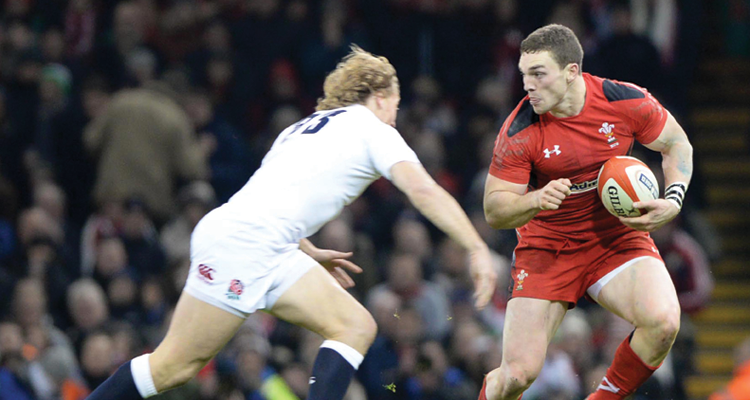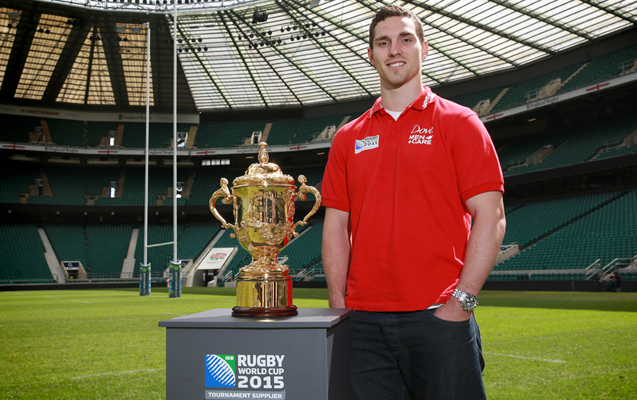George North: From ‘gangly’ speedster to formidable winger
The Welsh rugby prodigy on how carbs made him one of the world's most feared players and the biggest threat to English World Cup success

Three concussions in the space of five months threatened to jeopardise George North’s place at September’s Rugby World Cup, but following extensive rest, recovery and a confirmed inclusion in Wales’s 47-man training squad, the 23-year-old is set to play a key part in what will be a feared and highly motivated side.
His commitment to nonstop eating as well as relentless workouts using escalating density training (EDT) has seen North grow into a hybrid winger, combining raw speed with incredible strength and size, making him a huge threat to the likes of hosts England – whom he’ll face in Wales’s second game of the tournament.
When North and co return at the end of August from their summer training camp the squad will be whittled down to 31, followed by home and away warm-up matches against Ireland and a final warm-up game against Italy on 5th September.
‘The players will face a tough couple of months of intensive training,’ said Wales head coach Warren Gatland at the announcement of the initial 47-man squad. ‘I can assure everyone they are no holiday camps.
‘We put a lot of emphasis on conditioning and preparation in 2011, which worked well for us and we are looking to step that up again this time,’ Gatland said, having led Wales to the semi-finals of the last World Cup in New Zealand. 'We believe the longer we are together, the better we perform and this summer of preparation will give us every opportunity to be at our best come the Rugby World Cup.’
MF spoke to North to gain an insight into his staggering development, alongside his recovery from multiple head injuries and what this summer holds for Wales in the build up to the World Cup.
How did you transform your body to handle the rigours of rugby?
I was always tall and gangly. When I left home to play college rugby I was 6ft 3in [1.9m] and 80kg, which compared to now – I’m 6ft 4in [1.93m] and 106kg – is completely different. One of the main things that helped me put the size on was constant eating. I knew I needed to put size on to compete at this level so I was even eating when full, and followed a strict diet of high protein and carbs. People often shy away from carbs because they think it puts on bad weight, but when you’re trying to put weight on and training nonstop your body needs all the nutrition it can get.
Get the Coach Newsletter
Sign up for workout ideas, training advice, reviews of the latest gear and more.
What sort of training do you have planned for the summer in preparation for the World Cup?
We go to Switzerland first for the altitude stimulus where training will be relatively low-intensity. We call it ‘train low, live high’. Then we’ll go to Qatar purely for the heat stimulus. We speak a lot about cryotherapy and we’ve been doing it for a few years now but the opposite of the cold is the heat in Qatar. If we can survive that heat and perform well it will bring out the best in us. Then we go back to Poland [to use cryotherapy chambers to boost recovery] for ten days to refocus and freshen up ready for the first game of the World Cup.

What safety precautions, if any, have you put in place to protect against concussion?
I haven’t done anything special. People talk about protective headwear but scrumcaps only takes the impact out of any collisions. They don’t prevent the concussion risk, which is from the whiplash of your brain within the skull. You can strengthen your neck muscles to reduce that whiplash effect – similar to what formula one drivers do to handle the G-force when racing – and do a lot of rehab around your neck and shoulders to keep everything sturdy but I haven’t been giving it special attention.
Which sides are among the fittest at the World Cup?
The Southern hemisphere sides are very fit. They play at a high tempo all the time. We talk about ‘ball in play time’ and how many metres per minute you cover. Against Southern hemisphere sides they are a lot greater than us. The game they play is quicker, at a higher tempo and with less contact.
Who do you see as your toughest opponents in September?
England and Australia are two of the toughest teams we could play against. We play Uruguay first, then England, Fiji and finally Australia, so we should be able to peak at the right times and get better with each game.
The 2015 Rugby World Cup kicks off on 18th September when England face Fiji at Twickenham. On 20th September Wales take on Uruguay at the Millennium Stadium.
Dove Men+Care is proud to be an Official Tournament Supplier of Rugby World Cup, offering shower gels, face care and deodorants which deliver high performance and superior skin care. For your chance to win tickets #scrumtogether on @dovemen
